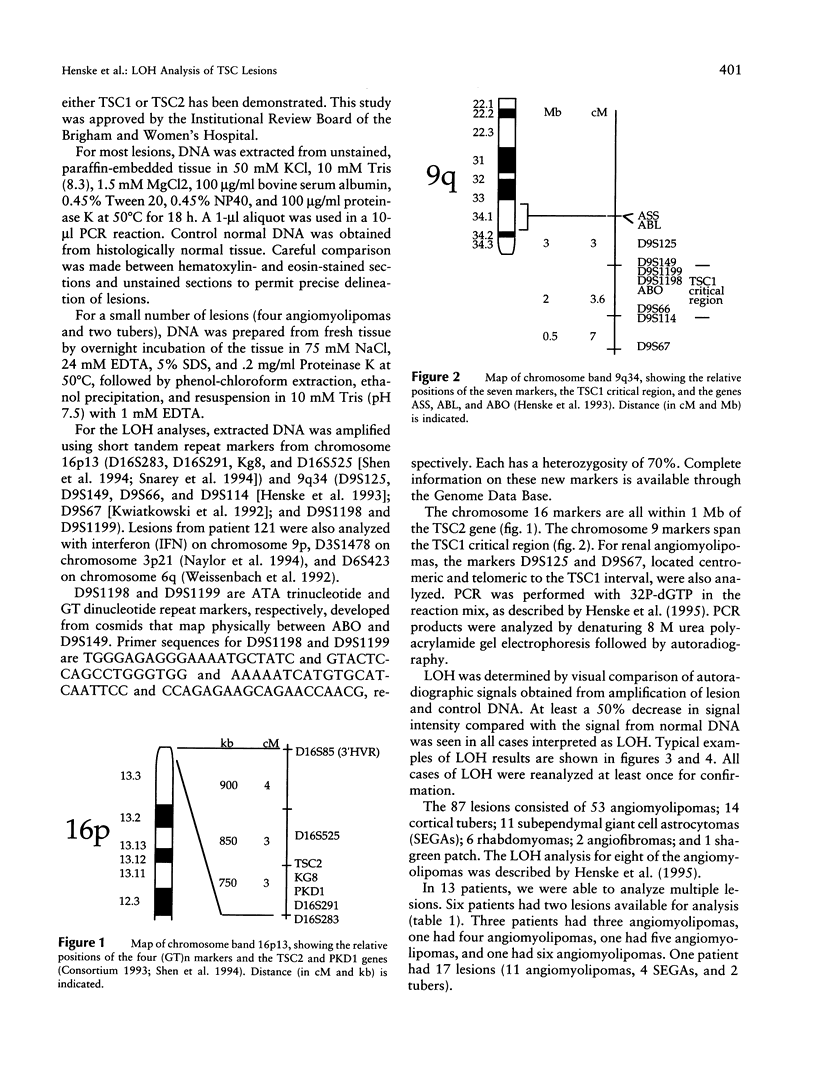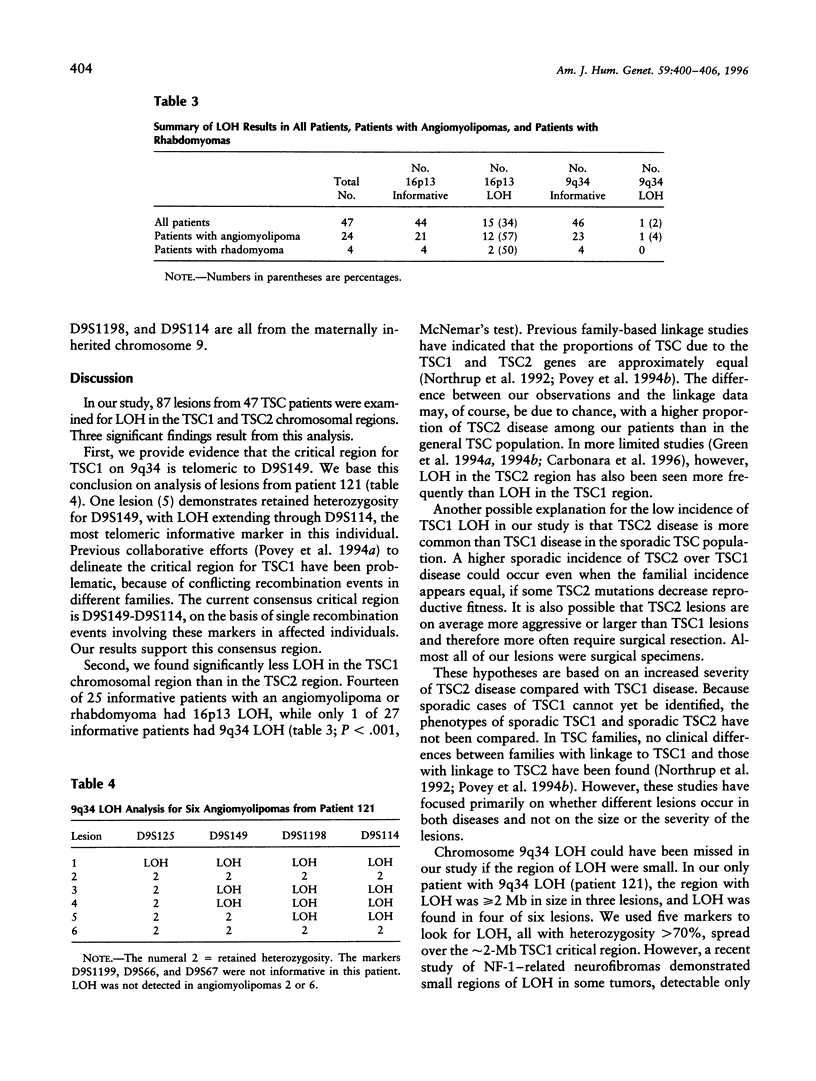Abstract
Tuberous sclerosis (TSC) is an autosomal dominant disorder characterized by seizures, mental retardation, and hamartomatous lesions. Although hamartomas can occur in almost any organ, they are most common in the brain, kidney, heart, and skin. Allelic loss or loss of heterozygosity (LOH) in TSC lesions has previously been reported on chromosomes 16p13 and 9q34, the locations of the TSC2 and TSC1 genes, respectively, suggesting that the TSC genes act as tumor-suppressor genes. In our study, 87 lesions from 47 TSC patients were analyzed for LOH in the TSC1 and TSC2 chromosomal regions. Three findings resulted from this analysis. First, we confirmed that the TSC1 critical region is distal to D9S149. Second, we found LOH more frequently on chromosome 16p13 than on 9q34. Of the 28 patients with angiomyolipomas or rhabdomyomas, 16p13 LOH was detected in lesions from 12 (57%) of 21 informative patients, while 9q34 LOH was detected in lesions from only 1 patient (4%). This could indicate that TSC2 tumors are more likely than TSC1 tumors to require surgical resection or that TSC2 is more common than TSC1 in our patient population. It is also possible that small regions of 9q34 LOH were missed. Lastly, LOH was found in 56% of renal angiomyolipomas and cardiac rhabdomyormas but in only 4% of TSC brain lesions. This suggests that brain lesions can result from different pathogenic mechanisms than kidney and heart lesions.
Full text
PDF






Images in this article
Selected References
These references are in PubMed. This may not be the complete list of references from this article.
- Carbonara C., Longa L., Grosso E., Borrone C., Garrè M. G., Brisigotti M., Migone N. 9q34 loss of heterozygosity in a tuberous sclerosis astrocytoma suggests a growth suppressor-like activity also for the TSC1 gene. Hum Mol Genet. 1994 Oct;3(10):1829–1832. doi: 10.1093/hmg/3.10.1829. [DOI] [PubMed] [Google Scholar]
- Carbonara C., Longa L., Grosso E., Mazzucco G., Borrone C., Garrè M. L., Brisigotti M., Filippi G., Scabar A., Giannotti A. Apparent preferential loss of heterozygosity at TSC2 over TSC1 chromosomal region in tuberous sclerosis hamartomas. Genes Chromosomes Cancer. 1996 Jan;15(1):18–25. doi: 10.1002/(SICI)1098-2264(199601)15:1<18::AID-GCC3>3.0.CO;2-7. [DOI] [PubMed] [Google Scholar]
- Colman S. D., Williams C. A., Wallace M. R. Benign neurofibromas in type 1 neurofibromatosis (NF1) show somatic deletions of the NF1 gene. Nat Genet. 1995 Sep;11(1):90–92. doi: 10.1038/ng0995-90. [DOI] [PubMed] [Google Scholar]
- Gomez M. R. Phenotypes of the tuberous sclerosis complex with a revision of diagnostic criteria. Ann N Y Acad Sci. 1991;615:1–7. doi: 10.1111/j.1749-6632.1991.tb37742.x. [DOI] [PubMed] [Google Scholar]
- Green A. J., Johnson P. H., Yates J. R. The tuberous sclerosis gene on chromosome 9q34 acts as a growth suppressor. Hum Mol Genet. 1994 Oct;3(10):1833–1834. doi: 10.1093/hmg/3.10.1833. [DOI] [PubMed] [Google Scholar]
- Green A. J., Smith M., Yates J. R. Loss of heterozygosity on chromosome 16p13.3 in hamartomas from tuberous sclerosis patients. Nat Genet. 1994 Feb;6(2):193–196. doi: 10.1038/ng0294-193. [DOI] [PubMed] [Google Scholar]
- Henske E. P., Kwiatkowski D. J. A 5.4-Mb continuous pulsed-field gel electrophoresis map of human 9q34.1 between ABL and D9S114, including the tuberous sclerosis (TSC1) region. Genomics. 1995 Jul 1;28(1):105–108. doi: 10.1006/geno.1995.1113. [DOI] [PubMed] [Google Scholar]
- Henske E. P., Neumann H. P., Scheithauer B. W., Herbst E. W., Short M. P., Kwiatkowski D. J. Loss of heterozygosity in the tuberous sclerosis (TSC2) region of chromosome band 16p13 occurs in sporadic as well as TSC-associated renal angiomyolipomas. Genes Chromosomes Cancer. 1995 Aug;13(4):295–298. doi: 10.1002/gcc.2870130411. [DOI] [PubMed] [Google Scholar]
- Henske E. P., Ozelius L., Gusella J. F., Haines J. L., Kwiatkowski D. J. A high-resolution linkage map of human 9q34.1. Genomics. 1993 Sep;17(3):587–591. doi: 10.1006/geno.1993.1376. [DOI] [PubMed] [Google Scholar]
- Hirose T., Scheithauer B. W., Lopes M. B., Gerber H. A., Altermatt H. J., Hukee M. J., VandenBerg S. R., Charlesworth J. C. Tuber and subependymal giant cell astrocytoma associated with tuberous sclerosis: an immunohistochemical, ultrastructural, and immunoelectron and microscopic study. Acta Neuropathol. 1995;90(4):387–399. doi: 10.1007/BF00315012. [DOI] [PubMed] [Google Scholar]
- Kwiatkowski D. J., Henske E. P., Weimer K., Ozelius L., Gusella J. F., Haines J. Construction of a GT polymorphism map of human 9q. Genomics. 1992 Feb;12(2):229–240. doi: 10.1016/0888-7543(92)90370-8. [DOI] [PubMed] [Google Scholar]
- Kwiatkowski D. J., Short M. P. Tuberous sclerosis. Arch Dermatol. 1994 Mar;130(3):348–354. [PubMed] [Google Scholar]
- Merlo A., Herman J. G., Mao L., Lee D. J., Gabrielson E., Burger P. C., Baylin S. B., Sidransky D. 5' CpG island methylation is associated with transcriptional silencing of the tumour suppressor p16/CDKN2/MTS1 in human cancers. Nat Med. 1995 Jul;1(7):686–692. doi: 10.1038/nm0795-686. [DOI] [PubMed] [Google Scholar]
- Murrell J., Trofatter J., Rutter M., Cutone S., Stotler C., Rutter J., Long K., Turner A., Deaven L., Buckler A. A 500-kilobase region containing the tuberous sclerosis locus (TSC1) in a 1.7-megabase YAC and cosmid contig. Genomics. 1995 Jan 1;25(1):59–65. doi: 10.1016/0888-7543(95)80109-y. [DOI] [PubMed] [Google Scholar]
- Naylor S. L., Buys C. H., Carritt B. Report and abstracts of the Fourth International Workshop on Human Chromosome 3 Mapping. Cytogenet Cell Genet. 1994;65(1-2):2–50. [PubMed] [Google Scholar]
- Northrup H., Kwiatkowski D. J., Roach E. S., Dobyns W. B., Lewis R. A., Herman G. E., Rodriguez E., Jr, Daiger S. P., Blanton S. H. Evidence for genetic heterogeneity in tuberous sclerosis: one locus on chromosome 9 and at least one locus elsewhere. Am J Hum Genet. 1992 Oct;51(4):709–720. [PMC free article] [PubMed] [Google Scholar]
- Povey S., Armour J., Farndon P., Haines J. L., Knowles M., Olopade F., Pilz A., White J. A., Kwiatkowski D. J. Report and abstracts of the Third International Workshop on Chromosome 9. Cambridge, United Kingdom, 9-11 April, 1994. Ann Hum Genet. 1994 Jul;58(Pt 3):177–250. doi: 10.1111/j.1469-1809.1994.tb01887.x. [DOI] [PubMed] [Google Scholar]
- Povey S., Burley M. W., Attwood J., Benham F., Hunt D., Jeremiah S. J., Franklin D., Gillett G., Malas S., Robson E. B. Two loci for tuberous sclerosis: one on 9q34 and one on 16p13. Ann Hum Genet. 1994 May;58(Pt 2):107–127. doi: 10.1111/j.1469-1809.1994.tb01881.x. [DOI] [PubMed] [Google Scholar]
- Sampson J. R., Scahill S. J., Stephenson J. B., Mann L., Connor J. M. Genetic aspects of tuberous sclerosis in the west of Scotland. J Med Genet. 1989 Jan;26(1):28–31. doi: 10.1136/jmg.26.1.28. [DOI] [PMC free article] [PubMed] [Google Scholar]
- Shen Y., Kozman H. M., Thompson A., Phillips H. A., Holman K., Nancarrow J., Lane S., Chen L. Z., Apostolou S., Doggett N. A. A PCR-based genetic linkage map of human chromosome 16. Genomics. 1994 Jul 1;22(1):68–76. doi: 10.1006/geno.1994.1346. [DOI] [PubMed] [Google Scholar]
- Snarey A., Thomas S., Schneider M. C., Pound S. E., Barton N., Wright A. F., Somlo S., Germino G. G., Harris P. C., Reeders S. T. Linkage disequilibrium in the region of the autosomal dominant polycystic kidney disease gene (PKD1). Am J Hum Genet. 1994 Aug;55(2):365–371. [PMC free article] [PubMed] [Google Scholar]
- Weissenbach J., Gyapay G., Dib C., Vignal A., Morissette J., Millasseau P., Vaysseix G., Lathrop M. A second-generation linkage map of the human genome. Nature. 1992 Oct 29;359(6398):794–801. doi: 10.1038/359794a0. [DOI] [PubMed] [Google Scholar]
- Wienecke R., König A., DeClue J. E. Identification of tuberin, the tuberous sclerosis-2 product. Tuberin possesses specific Rap1GAP activity. J Biol Chem. 1995 Jul 7;270(27):16409–16414. doi: 10.1074/jbc.270.27.16409. [DOI] [PubMed] [Google Scholar]




